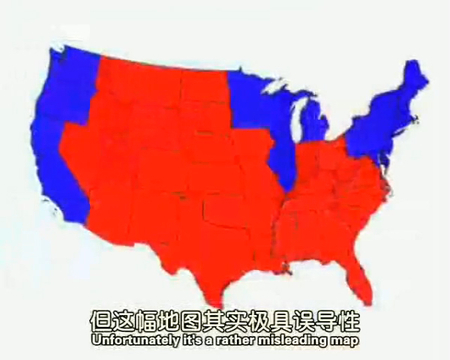Here's the poorest counties of Alabama
右邊的是阿拉巴馬幾個(gè)最窮的縣
and you can see how poor they can be
從數(shù)據(jù)可以看到,這些縣真的非常貧困
$17,000 for household income
每個(gè)家庭年收入僅為17000美元
32% percent for Bush 29% and so on
這些州有32%支持布什的,29%支持布什的
All these poor counties are all substantially African-American majority counties
所有的這些情況貧困的縣都是龐大的黑人聚集地
but the pattern though is the opposite from the red states to blue states
對比加州可知,在這方面紅色州與藍(lán)色州相反
With California and Alabama I think forming the sort of two extremes
加州和阿拉巴馬是兩種極端情況
which leads then to a big paradox
這形成了一個(gè)很大的矛盾
Rich places vote for the Democratic party
富裕的州傾向于民主黨
Rich people vote for the Republican party
富裕的人傾向于共和黨
How do we deal with this?
這種現(xiàn)象應(yīng)該怎么解釋呢?
Income and voting, for the Bush vote, again
再次來看這個(gè)收入及布什支持率表
Household income over $200,000, 62% for Bush
家庭收入超過2萬美金的選民中,有62%的人支持布什
over $50,000,57%, under $50,000,45%, under $15,000, 36%
家庭收入過5萬美金的 57%,收入低于5萬美金的支持率為45%,收入低于一萬五千美金的僅為36%
This is a real central paradox
這就是矛盾的中心所在

Really to understand this
要搞明白這個(gè)問題
You really get some insight into
你必須仔細(xì)研究
how the American election is geographically structured
美國的選情在地理上如何分布
and if you want a excellent overview of this
如果你想要清晰地了解其大致情況
You can read a recently written book
你可以去讀一本最近出版的書
called "red state, blue state, rich state, poor state" Andrew Gelman
《紅色州,藍(lán)色州,富裕州,貧窮州》作者是Andrew Gelman
"Why Americans Vote the Way They Do"
該書分析了美國人根據(jù)什么來投票
He has a lot of interesting things to say
書中討論了很多有意思的事情
Analyzing a tremendous amount of data
分析了大量的數(shù)據(jù)
What he would argue is that the poor people across the country vote pretty similarly
作者認(rèn)為,美國所有的窮人都有著非常相似的投票傾向
They vote for the Democratic party, in general
總體來說,他們都傾向于支持民主黨
In the red states more strongly so
在紅色州的窮人反而更傾向于民主黨
But still, it's a cross country pattern
不過這種概括是在全國的層面上分析的
We don't see it much in California
若具體到加州,這個(gè)概括則不起作用
perhaps and some other states
也許其他州也有與加州類似的現(xiàn)象
but it is through out the U.S
但全美大部分地區(qū)的確都有這個(gè)規(guī)律
Middle class and wealthier people are completely different story
中產(chǎn)階級和相對富裕的人情況則截然不同
In the Republican voting states
在紅色州
the middle class, and especially the upper class strongly Republican voting
中產(chǎn)階級,尤其是上流社會(huì),都是極忠實(shí)的共和黨支持者
In the blue states, the middle class pretty clearly Democratic voting
在藍(lán)色州,中產(chǎn)階級很明顯支持民主黨
and the upper class, if you will, split
上流社會(huì)支持兩黨的人都有
So he argues that this red-blue divide is something that happened among the affluent
因此作者認(rèn)為紅藍(lán)劃分的關(guān)鍵因素在于富足階層(中上階層)的支持情況
That's where the real differences
是他們導(dǎo)致了真正的不同
He further argues that you can see this not just in voting
同時(shí)他還指出,你會(huì)發(fā)現(xiàn),除了在投票方面
but in many other aspects of life
在很多其它方面也有這種情況
In a state like Alabama
例如在阿拉巴馬州
affluent people far more likely to attend church than poor people
富人比窮人更愿意參加教會(huì)活動(dòng)
and state like California, the opposite
而在加州,則情況相反
Alabama, affluent people far more likely to be culturally conservative
在阿拉巴馬富人在文化上較為保守
In California, affluent people far more likely to be culturally liberal
而加州的富人在文化上則較為開放
So his argument really is one about the affluent
因此他認(rèn)為造成這些差異的癥結(jié)在于富人不同的態(tài)度和選擇
half of the population or third of the population
富人常占一個(gè)州人口的1/2或1/3
Have you want to, pack that
你會(huì)看到
which has very different voting patterns and social attitudes from one part of the country to another
這些生活在美國不同地區(qū)的富人有著非常不同的投票傾向和社會(huì)態(tài)度



